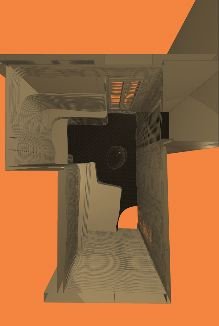Jorge Pardo
dal 7/2/2008 al 15/2/2008
Segnalato da
7/2/2008
Jorge Pardo
Galeria Elba Benitez, Madrid
Solo Show

“We live in a world where it makes less and less sense to go into these white rooms to contemplate art. In reality, this social space is not really working very hard any more at speaking about complexity.” [1]
Jorge Pardo
At the present moment, when the borderlines between art, design and architecture are becoming increasingly faint, Jorge Pardo (La Habana, 1963) constantly rebels against the boundaries of contemporary sculpture by planning each of his interventions in spaces as a new challenge, a way of delving into his own work.
According to Marcel Duchamp it was not the “painter, but the onlooker who makes the painting”, whereas for Jorge Pardo the artwork must also speak for itself. Based on the importance of a specific space where his work will be created and built, the presence of the onlooker, however, plays a similarly fundamental role. His spaces, places of experience, demand active visitors, individuals able to establish not only visual relationships with them but physical ones too. For Pardo, text alone furnishes a very superficial view of the work, and is never a substitute for experience: “Art is presence, and that cannot be captured when it is described in writing”[2]. His work, which features the public and the private, the art object and the manufactured product, as well as form and function, does not cater solely to a specialist audience.
Using a given space of 23 m2, Gran Vía 67, Madrid is simultaneously a work of architecture, an exhibition venue and an artwork. The artist strives to extricate the work from a conventional context, from the hallowed places for the contemplation of art, continuing along the lines explored by previous projects, such as the restaurant of the K21 Museum in Düsseldorf, 4166 Sea View Lane for the Museum of Contemporary Art of Los Angeles, and the Skulptur Projekte Münster 1997. Gran Vía 67 is not merely an artwork to be contemplated; it is a sculpture that can be lived in, a place in Madrid that invites the visitor to spend time and meditate there. In our ever changing society, the Galería Elba Benítez has chosen to back Jorge Pardo’s controversial view about the role art should play today.
Jorge Pardo (La Habana, 1963) studied at The Art Center College of Design in Pasadena, California. He currently lives and works in Los Angeles. Throughout his career he has combined exhibitions in museum spaces with interventions specifically designed for less conventional places. Pardo was invited to take part in the 26th Biennial of Sao Paulo (2004) as Guest Artist. His work has been shown at numerous solo exhibitions at art centres including, among others, the Dia Art Foundation en New York (2003), Kunsthalle Basel in Switzerland (2000), The Fabric Workshop in Philadelphia (1999) and the Museum of Contemporary Art of Chicago (1997). In December 2007, his exhibition House will open at the Museum of Contemporary Art (MOCA) in Miami. The event will be accompanied by the publication of an in-depth study of his work, which will be available for consultation at the gallery.
[1] “Interview with Jorge Pardo” in Jorge Pardo: un projecte per a la col·lecció d'art contemporani fundació "La Caixa", Barcelona, Fundació “la Caixa”, 2004, p. 59.
[2]“Interview with Jorge Pardo“ in Schafaff, Steiner, Jorn, and Barbara (eds.): Jorge Pardo, Ostfildern-Ruit, Hatje Cantz Verlag, 2001, p. 18.
The exhibition will be held at the address Gran Vía nº 67, 9th floor, 28013 Madrid (Metro Plaza de España) instead of at the gallery’s usual space. From Tuesday through Saturday from 11 am through 2 pm and 4.30 through 8.30 pm
Galeria Elba Benitez
San Lorenzo, 11 Madrid
Free admission



